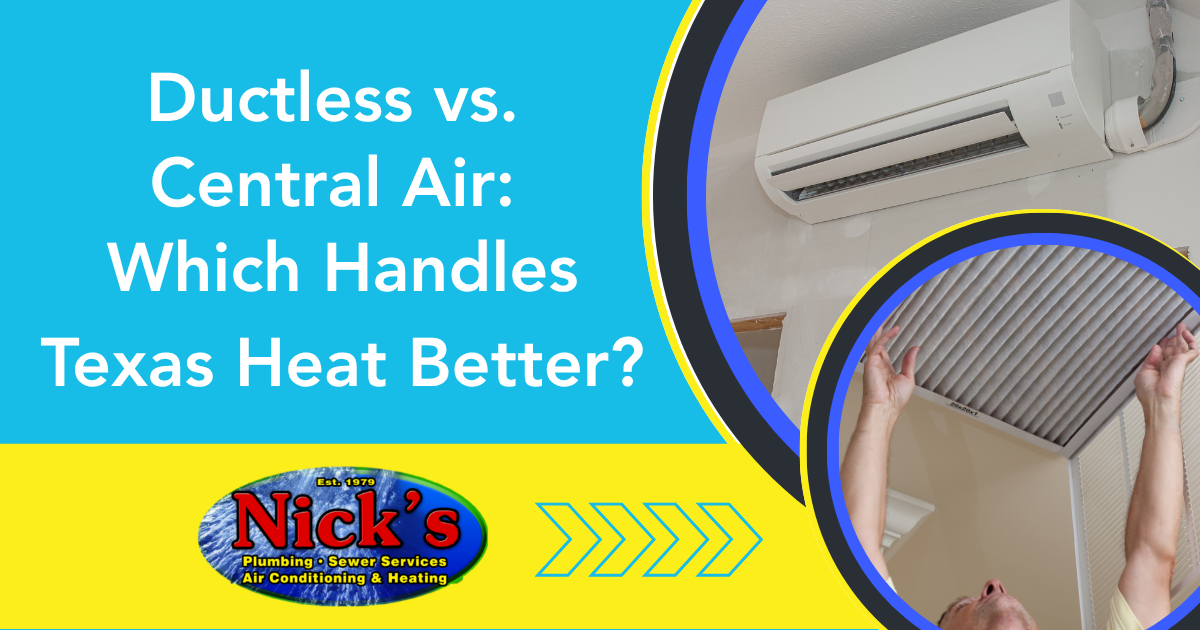Author: Jeff O'Hara
When Houston homeowners start thinking about replacing or upgrading their air conditioning, there is one question we hear more and more in the field, and that’s “Should
I go with a single whole-house central HVAC system or multiple ductless mini-split units?”
Both systems have their strengths, but the “right” answer really depends on the design house, your comfort preferences, and your budget.
Let’s break down how these two systems work, how well they hold up against Texas heat, and what you can expect from each choice in terms of energy efficiency, installation, maintenance, and potential repair that can restore your overall comfort.
What’s the Difference Between Ductless and Central Air Systems?
Central HVAC systems use permanently installed ducts to move conditioned air through the entire home. In contrast, a ductless mini-split system skips the ductwork entirely, cooling or heating each room (or “zone”) with its own wall- or ceiling-mounted unit.
How Ductless Mini Split Systems Work
Mini splits have two main parts: an outdoor condenser unit and one (or more) indoor air handlers. Each indoor unit connects to the outdoor unit through a small conduit that runs through the wall. Because each indoor unit has its own thermostat, you can cool one room without affecting any other area of the house. This kind of zoned comfort control is one of the key selling points for ductless systems.
Mini Split System Takeaways:
- Flexible Design: Great for older homes without ductwork or for cooling new additions.
- Room-By-Room Control: Each unit can be set to a different temperature.
- Energy Efficiency: Eliminates duct losses, which can account for up to 30% of wasted cooling and heating in central systems.
How Central Air Conditioning Works
Whole-house central AC systems rely on a single outdoor unit and an indoor air handler that pushes conditioned air through a network of ducts. Supply vents deliver the cool air, and return vents pull warm air back to the system. In a perfect world, this setup keeps the whole house at one consistent temperature, as long as the ducts are properly sealed and balanced.
Whole-House Central HVAC System Takeaways:
- Whole-Home Cooling: Best for larger homes that need to maintain a consistent temperature throughout the home.
- Hidden Equipment: Only the vents are visible, so it doesn’t interfere with décor.
- Integrated Filtration: Filters all the air that circulates through the ducts, which can help allergy sufferers.
Which System Performs Better in Texas Heat?
Look, it’s no secret that Houston summers are absolutely brutal. Both central air and ductless mini-splits are designed to handle extreme heat, but they do it differently. Central AC does its best work in larger homes, keeping every room consistently cool, which is crucial if you have multiple floors or open layouts.
Ductless systems, on the other hand, allow you to cool only the rooms you’re actually using. That means your bedroom can stay icy cold at night without wasting energy cooling the dining room. Many homeowners find that mini-splits feel that the unit’s performance is “stronger” because there’s no duct loss—the cool air blows directly from the compressor unit into the room.
So, the big question becomes, are ductless mini-split systems as effective as a central HVAC in Texas summers? Yes, they are, but they come with a caveat. If you want to cool a 3,000-square-foot house to 72 degrees all day, central air is going to be the more practical option. If you’re looking for a system that provides targeted comfort that you can control down to a specific room, you’ll find that ductless mini-splits can absolutely help your home do battle with the summer heat.
Which Option Saves You More on Energy Bills?
Now we get to where ductless systems usually have the edge. By eliminating ductwork, mini-splits will avoid the leaks and energy loss that ducted systems experience, which can dramatically drive up utility bills. If you factor in the mini-splits’ ability to cool (or heat) only the rooms you’re using, you’ll be looking at significant savings over time.
Newer whole-house central HVAC systems are designed with efficiency and performance in mind, making them more efficient—especially models that offer variable-speed compressors and smart thermostats. If you take into account the unavoidable 20 – 30% duct losses, it appears to tip the scales in favor of ductless systems. The majority of homeowners who switch from central HVAC systems to ductless generally see their energy bills drop by 20–30%, depending on usage.
Installation Costs & Homeowner Considerations
If your home already has pre-installed ductwork that is in good condition, a whole-house central HVAC system is going to be your less expensive option upfront. Replacing an old outdoor central AC unit with a new one doesn’t require major modifications, just a swap of the main components and making the connections to the home.
If you live in an older home – like those in our historic districts of Montrose and the Heights – that doesn’t have existing ductwork, installing it is a messy and costly endeavor. Retrofitting ducts into an older home may require tearing into walls, floors, or ceilings, something many homeowners would rather avoid. In these scenarios, homeowners who install mini-split systems in Texas often come out ahead, as it requires only a small opening for the conduit and significantly less labor.
Maintenance & Lifespan.
Both systems will require regular maintenance that is performed on a fixed schedule if the homeowner intends for their system to run efficiently and operate at peak performance.
When discussing the potential lifespan of a central HVAC system, we say that most quality systems will generally give you 12–15 years of solid performance, while ductless mini-splits can reach 15–20 years, provided that they are both properly maintained. Mini-splits require more frequent filter cleaning—often monthly—since each indoor unit has its own filter. Central systems usually need filter changes every one to three months, depending on the filter type and conditions within your household.
Comfort, Noise, and Air Quality. Which System Does Them Better?
Zoning & Temperature Control
Central systems cool the entire home at once, which is excellent for uniform comfort but wasteful if you’re only using a couple of rooms. Mini-splits excel at zoning, allowing each room to be set to its own temperature. This makes them ideal for households where family members have different comfort preferences, and they can be programmed to cool that room at a particular time, say, a half hour before you get home from work.
Noise Levels
Central HVAC systems generate a good amount of background noise from air passing through ducts, especially if the ducts are older or undersized. The amount of noise generated by your outdoor unit will be based on the age and condition of the system.
Mini-splits tend to be whisper-quiet indoors, with most of the noise kept outside at the condenser. Being much smaller than a whole-house HVAC system, and the fact that there are no loud blower motors or large fans installed, makes mini-splits a nice, quiet option for you and your next-door neighbors.
Indoor Air Quality
Central HVAC systems often do a better job filtering allergens, since all air passes through a filter before being circulated. Mini-splits improve air quality in another way: by reducing humidity more efficiently in the rooms they serve. That’s especially valuable in Houston, where high humidity can make even the coolest home still feel a little sticky.
How to Decide Which System is Right for You
There’s no one-size-fits-all answer in the ductless vs central air debate. It really comes down to the age of your home, whether you already have ducts, your budget, and how much control you want over your comfort.
- If your home has existing ductwork and you want whole-home, uniform cooling, central air is usually the way to go.
- If you’re in an older home without ducts—or you’re more interested in efficiency and zoning—mini-splits may be the smarter investment.
Some Houston homeowners have even chosen to use both, relying on their central AC system for most of the house and adding ductless units in harder-to-cool areas like sunrooms, garages, or upstairs bedrooms.
Frequently Asked Questions
Which Lasts Longer—Ductless Mini-Splits or Central AC Systems?
Ductless systems usually edge out central HVAC systems by a few years, with an expected lifespan of closer to 20 years when regularly maintained.
How Often Should Filters Be Cleaned or Replaced?
Mini-split filters usually require monthly cleaning, meaning you remove any debris that has collected on the filter and place it back in the mini-split unit. Whole-house central air conditioner filters typically need to be replaced every one to three months, depending on the amount of dust and debris in your home.
Can Ductless Systems Improve Indoor Air Quality Over Central Air?
They don’t filter the whole house like central systems, but they excel at reducing humidity and avoiding duct dust, which can make rooms feel fresher.
Why Choose Nick’s for Your Central HVAC or Mini-Split AC Installation? When it comes to something as important as cooling your home in Texas, you want advice from people who live here, work here, and know the climate inside and out. Nick’s Air Conditioning has decades of experience installing both whole-house central HVAC systems and ductless mini-splits in Houston homes.
Trane® makes all of our whole-house HVAC systems, and Mitsubishi™ Electric makes all of our mini-split units to guarantee that we’re installing high-quality, long-lasting comfort technology that will last you decades. Our licensed technicians can walk you through the pros and cons for your specific house and consult with you to make a decision that balances comfort, efficiency, and cost.


